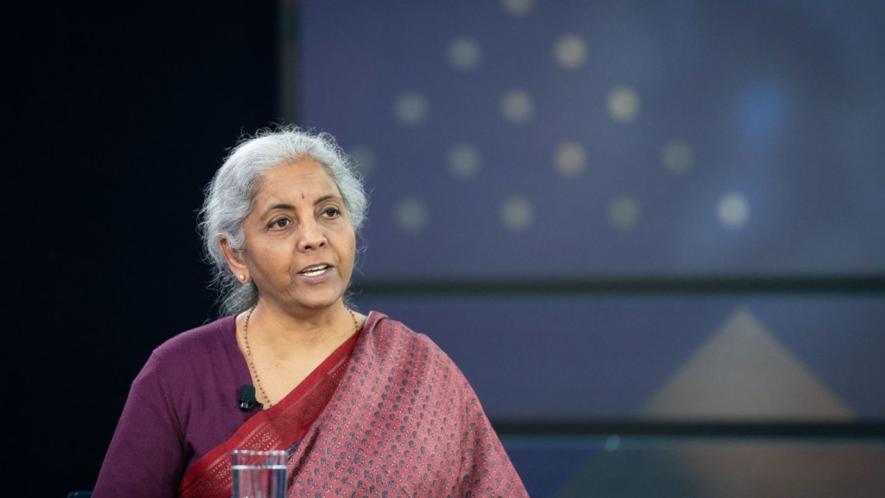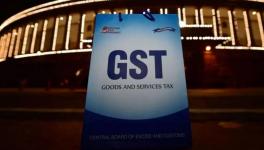Political Economy of GST Rejig

Nirmala Sitharaman, Minister of Finance of India. Image Courtesy: Flickr
The government of India has hailed the latest Goods and Services Tax (GST) restructuring as a “Diwali gift” for the Indian people. Beginning September 22, 2025, the GST Council has shrunk the earlier four-rate GST structure of 5%, 12%, 18% and 28% into two primary slabs, 5% and 18%, while introducing a new 40% “de-merit” slab supposedly for luxury and "sin" goods.
The Finance Ministry officials claim this will “simplify the tax system” and reduce burdens on households. However, far from being a ‘gift’ (on which more later), the changes amount to little more than a rejig that leaves the underlying structure of India’s regressive fiscal regime firmly embedded in the neoliberal project.
Read Also: PM Modi’s Diwali ‘Gift’ is Paid by People!
At first glance, it would seem that some everyday essentials have been moved to the 5% slab, while a wide band of goods and services remain at 18%. The 40% rate is targeted at commodities, such as luxury cars, aerated drinks, and tobacco products. But cesses that top up GST rates will remain and may be enhanced in ways that nullify any GST reductions on some segments of the economy.
Yet the key fact is this: unless there is a dip in government tax revenues, the tax burden on working households will remain unchanged. As long as the Indian government is bound to a neoliberal fiscal stance due to the Fiscal Responsibility and Budget Management (FRBM) Act and the absence of capital controls, the government will either cut expenditure or increase other taxes to maintain the FRBM fiscal target.
Let us see how.
GST remains an indirect tax. By definition, it taxes consumption goods and intermediates, not income or wealth. Effectively the payment of indirect taxes is shifted towards the working people (who are kept divided and therefore less capable of combatting this tax shifting under capitalist conditions).
In this regard, moving a handful of commodities into the 5% GST category does not alter the fundamentally regressive nature of the tax system since the bulk of goods and services are still taxed at 18%.
Even for those commodities whose GST rates are cut, it is possible that (especially larger) companies may absorb such tax reductions to increase their profit margins. Talk about anti-profiteering enforcement is less significant since the Indian government itself is demonstrably not immune to policy capture by monopoly capital. Thus, the festive cheer of "cheaper goods" is the stuff of political theatre that the current ruling dispensation is well known for.
There is also a deeper macroeconomic concern.
If tax revenues remain steady after the GST rejig, it means the working people see no real increase in their post-tax incomes.
If tax revenues fall, the government, guided by the FRBM Act, will cut public expenditure. This cut will translate into a fall in demand and output (and all the more if crowding in of private investment by public investment works in reverse). Reduced demand slows output and employment, which then depresses tax revenues further, creating a vicious cycle.
Read Also: GST Reforms & US Tariffs: Why Pro-People Policies Are Imperative
One group that has been vocal in its support for the GST rejig are some segments of industrial capital. By correcting “inverted duty structures” in sectors, such as textiles, fertilisers, and auto parts, the GST rejig it is hoped will at least partially mitigate the effects of the US trade war against India. However, if only profits of these segments rise, then the resulting fall in the post-tax share of income of the working people (who consume most of their income, unlike capitalists) will lead to a fall in capacity utilisation and, therefore, investment, output and employment.
These effects can be offset at least partially if the GST rejig results in the rise of exports of those commodities whose GST rates have declined. But this is unlikely to happen for at least two reasons.
One, these GST rate cuts may, as previously argued, increase profit margins with no fall in prices of such commodities.
Second, even if prices of such commodities fall, it is possible that governments of countries who compete with Indian exporters will themselves cut taxes for their exporters, which will largely nullify whatever positive demand effects the GST rejig in India may give rise to.
The language of a “Diwali gift” is demonstrative of the undemocratic political theatre of the current ruling dispensation. The working people are not mendicants who are meant to yearn for the largesse of the government that is beholden to monopoly capital. In fact, net output is itself the outcome of their labour and what is being bandied about as a "gift", even if it materialises, is merely a reduction in their exploitation, i.e., they are merely receiving a slightly larger share of what they themselves produced.
Since the GST rejig by itself is unlikely to stimulate the Indian economy, what is required instead is a set of policies that breaks with the neoliberal project in India.
This set of policies has to begin with the instituting of capital controls on (US-centred) international finance capital, which will enable government expenditure to become free of the magnitude of tax revenue, involving, inter alia, the abolition of the FRBM Act.
Fiscal policy will then become capable of both stimulating and stabilising output. This can be followed by putting in place modest rates of taxes on the wealth and income of billionaires. As long as the resultant tax revenue is used to enhance public expenditure, not only will output and employment rise, but so will profits. All this will allow indirect taxes to be reduced and not merely rejigged.
Shirin Akhter is Associate Professor at Zakir Husain Delhi College, University of Delhi. C Saratchand is Professor, Department of Economics, Satyawati College, University of Delhi. The views are personal.
Get the latest reports & analysis with people's perspective on Protests, movements & deep analytical videos, discussions of the current affairs in your Telegram app. Subscribe to NewsClick's Telegram channel & get Real-Time updates on stories, as they get published on our website.
























